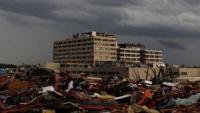-
Mitigating impact of rising seas, storms along California’s coast
New coastal modeling research presents state, federal, and commercial entities with varying storm and sea level-rise scenarios to assist with planning for future infrastructure and mitigation needs along the California coast.
-
-
Droughts caused permanent loss to major California groundwater source
California’s Central Valley aquifer, the major source of groundwater in the region, suffered permanent loss of capacity during the drought experienced in the area from 2012 to 2015.
-
-
February 2019 ranked fifth hottest month on record for the globe
We recently concluded the second full month of 2019, and already the year to date has turned out on the warm side. Steady warmth around the globe made February the fifth hottest on record. Seasonally, the period from December 2018 through February 2019 ranked fourth hottest on record.
-
-
Potential impacts of future heat waves on humans and wildlife
Climate change is often talked about in terms of averages — like the goal set by the Paris Agreement to limit the Earth’s temperature increase to 2 degrees Celsius. What such numbers fail to convey is that climate change will not only increase the world’s average temperature, it will also intensify extreme heat waves that even now are harming people and wildlife.
-
-
Keeping first responders, high-risk workers safer
Researchers have created a motion-powered, fireproof sensor that can track the movements of firefighters, steelworkers, miners and others who work in high-risk environments where they cannot always be seen.
-
-
Smart sensor to enhance emergency communications
First responders run toward danger; their jobs require it. Often, their only connection to the outside world during these rescue missions is their colleagues at the command centers who coordinate the rescue effort. with the ubiquity of IoT devices now, first responders have access to a vast, timely, and smart network of connections to the outside world.
-
-
Feeling the heat: Recognizing the risks of extreme weather
Heat waves are more dangerous than tornadoes, statistically. They kill more people than sharks, and put more human lives at risk than blizzards, floods or lightning storms. But they lack a certain dramatic flair, making it surprisingly difficult for many people to grasp and evaluate the real danger lurking behind their devastating effects. Recognizing those risks could be a matter of life or death – especially as a changing climate is making dangerous extreme heat events more and more likely every year in the United States.
-
-
Human brains vulnerable to voice morphing attacks

A recent research study investigated the neural underpinnings of voice security, and analyzed the differences in neural activities when users are processing different types of voices, including morphed voices.The results? Not pleasing to the ear. Or the brain.
-
-
Dealing with disaster

It took less than 90 minutes before students in Miaki Ishii’s first-year seminar started to talk openly about revolt. The unrest, however, wasn’t due to any political issue currently making headlines, but to a small room in Harvard’s Geological Museum and a handful of their classmates. The students took part in a role-playing game that saw them acting as citizens of the island of Montserrat, the tiny country’s government, and a group of scientists monitoring the island’s volcano. Why revolt? Because the students soon grew skeptical of the government’s ability to quickly and effectively respond to pressing environmental concerns.
-
-
Climate tool points to end of winter by 2050
Researchers have designed a tool which takes existing data and communicates the impacts of climate change in a way that people can engage with and better understand. The resulting new climate tool visualizes data which shows by 2050, Australians will no longer enjoy winter as they know it today and will experience a new season the designers are calling “New Summer.”
-
-
Forecasters use Iron Dome science to handle disasters

Typhoons, floods, droughts, earthquakes, hurricanes, wildfires — the frequency and intensity of natural disasters across the globe are worsening, and these deadly events could continue plaguing the planet as a result of climate change. Iron Dome tech firm uses rocket science to enable utilities to plan for and manage effects of wildfires, storms, hurricanes and earthquakes.
-
-
Laying groundwork for off-world colonies

Space economy is estimated to reach $1.1 trillion by 2040, but before civilization can move off world it must make sure its structures work on the extraterrestrial foundations upon which they will be built. Researchers are already laying the groundwork for the off-world jump by creating standards for extraterrestrial surfaces.
-
-
Using concrete for space colonies
“Be prepared.” This famous mantra isn’t just for the Boy Scouts of America. The need to build durable infrastructure on other planets is coming, and we must be ready. To prepare, researchers have been exploring how cement solidifies in microgravity environments.
-
-
Wildfire risk in California no longer linked to winter precipitation
From 1600 to 1903, the position of the North Pacific jet stream over California was linked to the amount of winter precipitation and the severity of the subsequent wildfire season, the team found. Wet winters brought by the jet stream were followed by low wildfire activity, and dry winters were generally followed by higher wildfire activity. Wet winters no longer predict possible relief from severe wildfires for California, according to a new study.
-
-
Fast, simple new method for assessing earthquake hazard
Geophysicists have created a new method for determining earthquake hazards by measuring how fast energy is building up on faults in a specific region, and then comparing that to how much is being released through fault creep and earthquakes.
-
More headlines
The long view
Autonomous Vehicle Technology Vulnerable to Road Object Spoofing and Vanishing Attacks
Researchers have demonstrated the potentially hazardous vulnerabilities associated with the technology called LiDAR, or Light Detection and Ranging, many autonomous vehicles use to navigate streets, roads and highways. The researchers have shown how to use lasers to fool LiDAR into “seeing” objects that are not present and missing those that are – deficiencies that can cause unwarranted and unsafe braking or collisions.
Tantalizing Method to Study Cyberdeterrence
Tantalus is unlike most war games because it is experimental instead of experiential — the immersive game differs by overlapping scientific rigor and quantitative assessment methods with the experimental sciences, and experimental war gaming provides insightful data for real-world cyberattacks.
Prototype Self-Service Screening System Unveiled
TSA and DHS S&T unveiled a prototype checkpoint technology, the self-service screening system, at Harry Reid International Airport (LAS) in Las Vegas, NV. The aim is to provide a near self-sufficient passenger screening process while enabling passengers to directly receive on-person alarm information and allow for the passenger self-resolution of those alarms.
Falling Space Debris: How High Is the Risk I'll Get Hit?
An International Space Station battery fell back to Earth and, luckily, splashed down harmlessly in the Atlantic. Should we have worried? Space debris reenters our atmosphere every week.
Testing Cutting-Edge Counter-Drone Technology
Drones have many positive applications, bad actors can use them for nefarious purposes. Two recent field demonstrations brought government, academia, and industry together to evaluate innovative counter-unmanned aircraft systems.
Strengthening the Grid’s ‘Backbone’ with Hydropower
Argonne-led studies investigate how hydropower could help add more clean energy to the grid, how it generates value as grids add more renewable energy, and how liner technology can improve hydropower efficiency.
